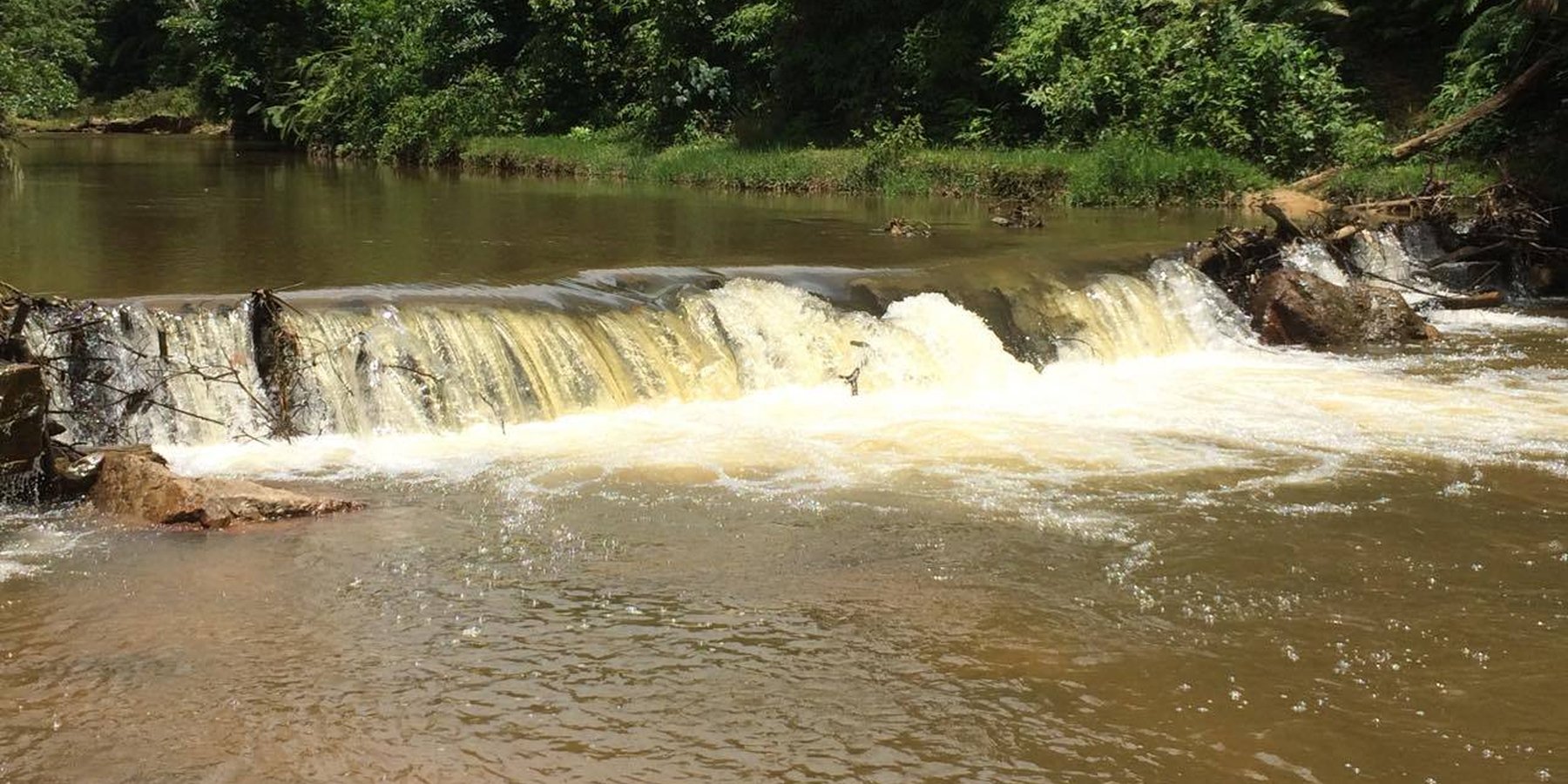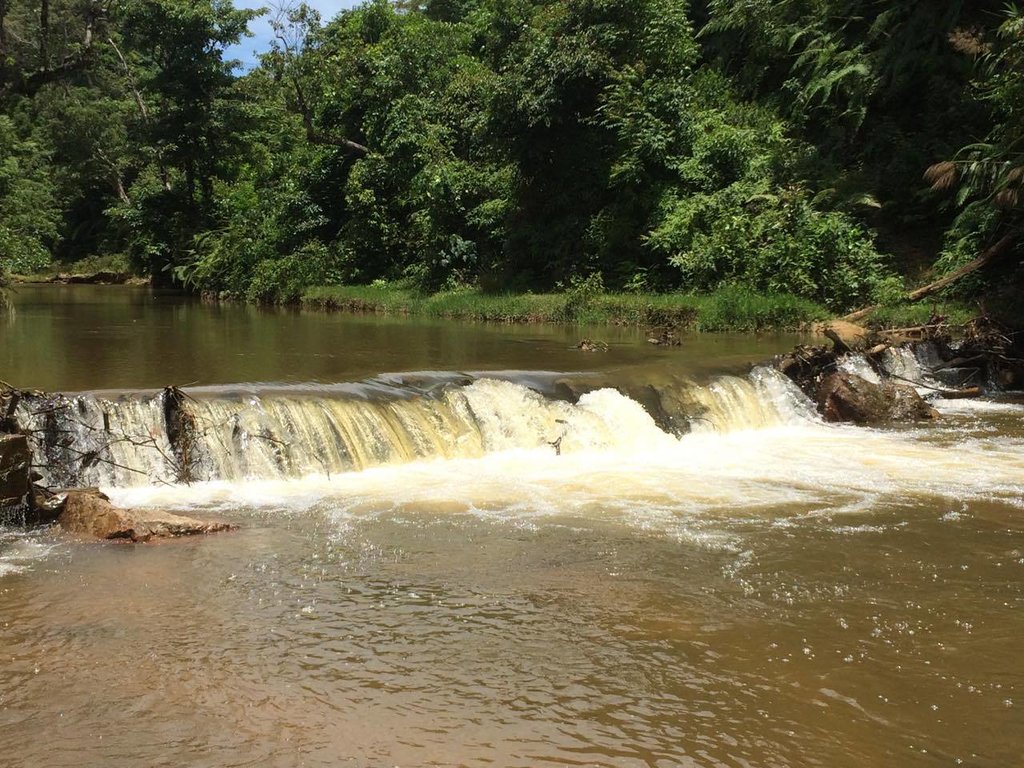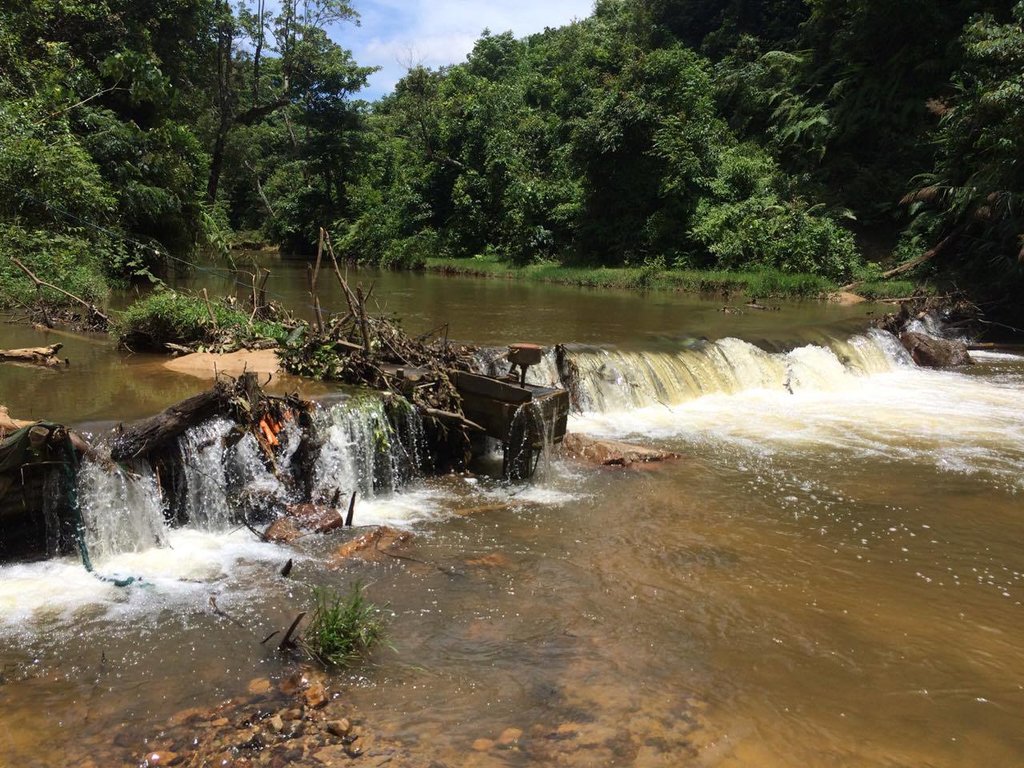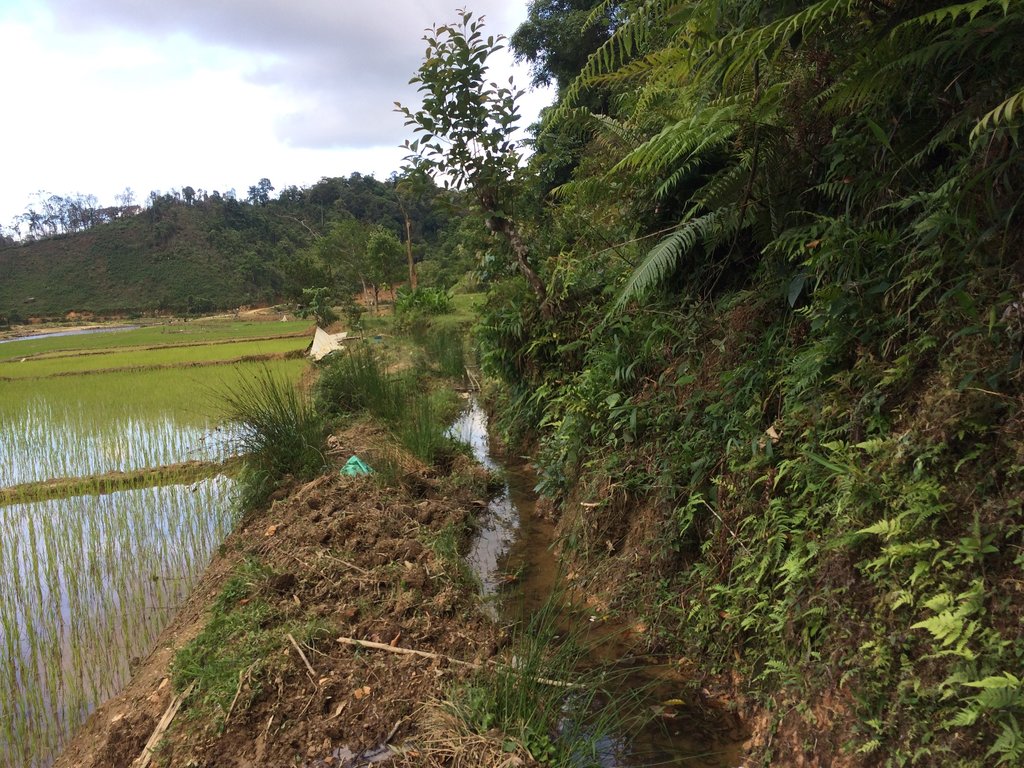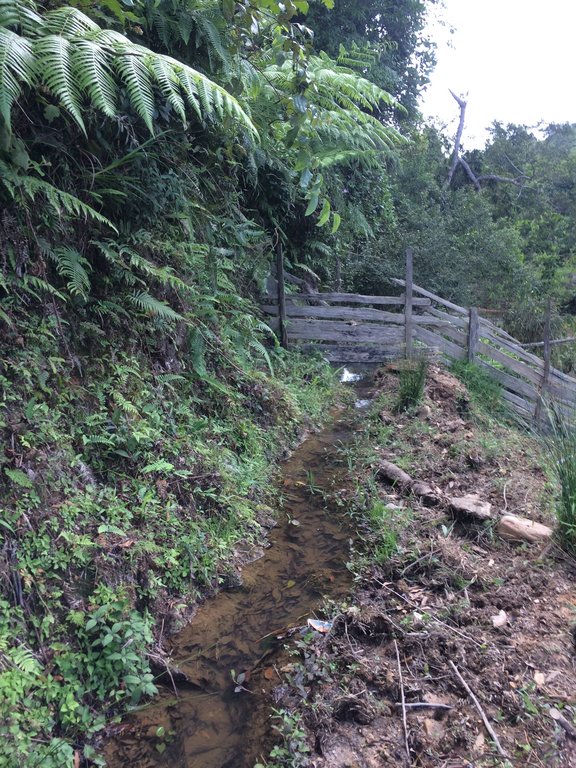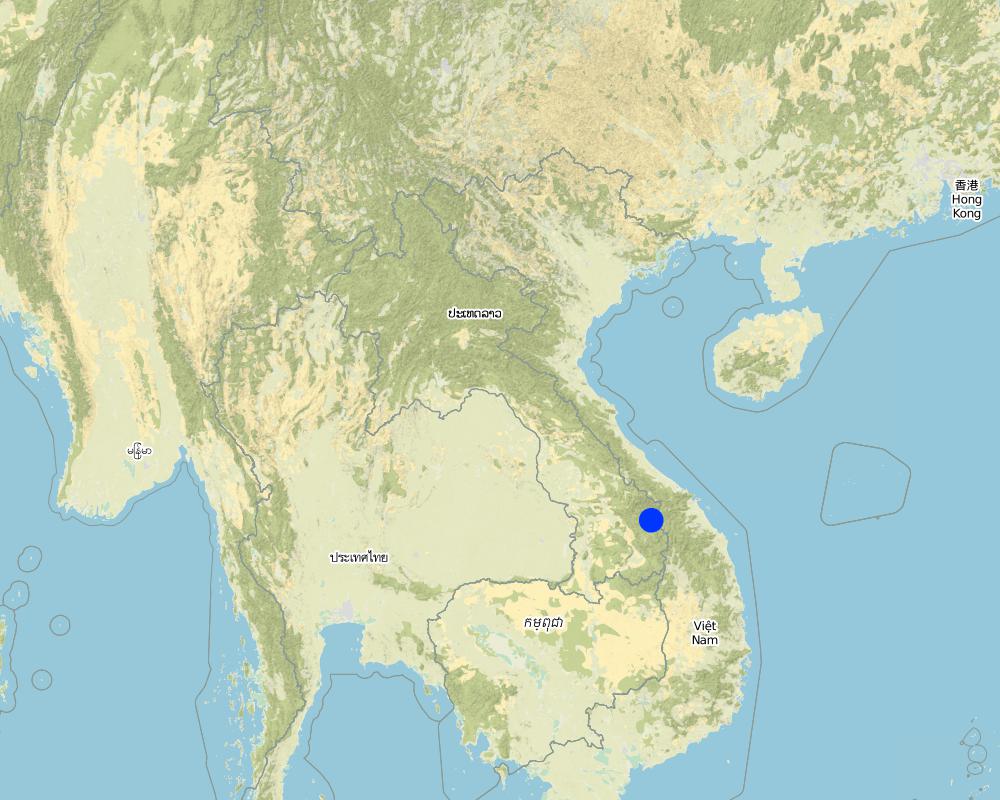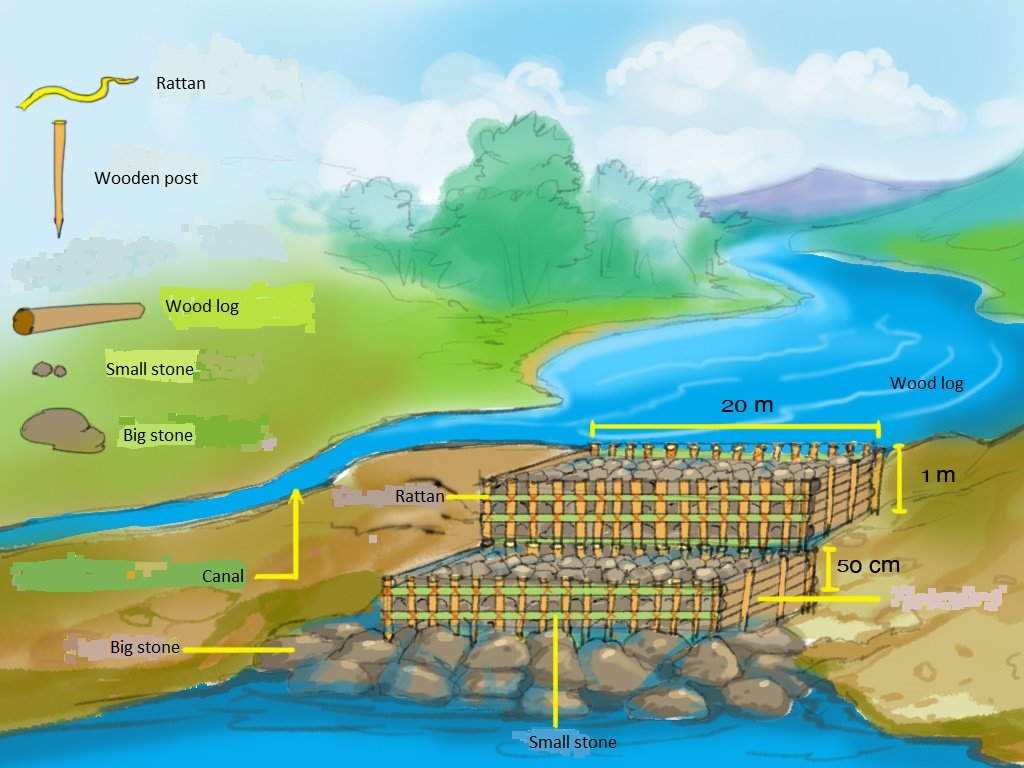Local indigenous dyke for water harvesting [ลาว]
- ผู้สร้างสรรค์:
- การอัพเดท:
- ผู้รวบรวม: kang phanvongsa
- ผู้เรียบเรียง: Pasalath Khounsy, Bounthanom Bouahom, anousit namsena
- ผู้ตรวจสอบ: viengsavanh phimphachanhvongsod, Stephanie Jaquet, Nicole Harari
technologies_2306 - ลาว
ดูส่วนย่อย
ขยายทั้งหมด ย่อทั้งหมด1. ข้อมูลทั่วไป
1.2 รายละเอียดที่ติดต่อได้ของผู้รวบรวมและองค์กรที่เกี่ยวข้องในการประเมินและการจัดเตรียมทำเอกสารของเทคโนโลยี
วิทยากรหลัก
ผู้ใช้ที่ดิน:
Sengmany
02096124255
Tangnong village, Dakchaung district, Sekong province
ลาว
ผู้ใช้ที่ดิน:
Sekhamphone Yangmao
0309946972
Tangnong village, Dakchaung district, Sekong province
ลาว
ผู้เชี่ยวชาญ SLM:
ชื่อของโครงการซึ่งอำนวยความสะดวกในการทำเอกสารหรือการประเมินเทคโนโลยี (ถ้าเกี่ยวข้อง)
Scaling-up SLM practices by smallholder farmers (IFAD)ชื่อขององค์กรซึ่งอำนวยความสะดวกในการทำเอกสารหรือการประเมินเทคโนโลยี (ถ้าเกี่ยวข้อง)
National Agriculture and Forestry Research Institute (NAFRI) - ลาว1.3 เงื่อนไขการใช้ข้อมูลที่ได้บันทึกผ่านทาง WOCAT
วันที่เก็บรวบรวมข้อมูล(ภาคสนาม) :
11/05/2017
ผู้รวบรวมและวิทยากรหลักยอมรับเงื่อนไขเกี่ยวกับการใช้ข้อมูลที่ถูกบันทึกผ่านทาง WOCAT:
ใช่
1.4 การเปิดเผยเรื่องความยั่งยืนของเทคโนโลยีที่ได้อธิบายไว้
เทคโนโลยีที่ได้อธิบายไว้นี้เป็นปัญหาของความเสื่อมโทรมโทรมของที่ดินหรือไม่ จึงไม่ได้รับการยอมรับว่าเป็นเทคโนโลยีเพื่อการจัดการที่ดินอย่างยั่งยืน:
ไม่ใช่
2. การอธิบายลักษณะของเทคโนโลยี SLM
2.1 การอธิบายแบบสั้น ๆ ของเทคโนโลยี
คำจำกัดความของเทคโนโลยี:
A Local Indigenous Weir to Harness Water
2.2 การอธิบายแบบละเอียดของเทคโนโลยี
คำอธิบาย:
Local villagers initiated the construction and use of communal weir with locally available materials such as wood and stones to create structure and stabilize the weir. Previously, the local people had constructed several irrigation weirs on a particular stream with each one being adjacent to an individual farm. However this arrangement created water use conflicts, particularly during dry season. Therefore people decided to group together in 2003 in order to build a communal weir and vowed to maintain it on an annual basis. This was a significant commitment as often it is difficult to find the necessary construction materials for the weir’s upkeep.
The main features and components of its framework should be prepared in the following manner: Firstly prior to beginning the weir’s construction one should gather rattan with length of 1-1.5 meters to tie the logs with each posts, as well as post with a diameter approximately 10 cm that should be cut to a length of 1.5 meters. The posts should then be sharpened at the end so that they can ideally be driven 50 cm into the ground, but this will depend on the conditions at the weir site. There should be a distance of 50 cm between each of the posts and these should be installed in two parallel rows with a space of 1 meter between the rows each rows width 1 meters and height 1 meter from the ground that cross the stream about 25 meters long.
Once this has been completed logs with diameter about 20 cm and a length of 4-5 meters should be slotted behind the rows posts and lay the another logs on the previous post until reach to the top of the post as the first layer. The second layer behind the logs should consist of small stones, soil, as well as branches and sticks. This procedure should be completed until the wall of horizontal logs has reached the height 1 meter of the top of the posts. Afterwards large stones should be placed as the top layer of the weir’s crest in order to strengthening the weir from flash flood. After that continue repeating the same process for the second row, driven the posts into the ground for 50 cm in front of the first row with distance of 1 meter and lower than first low for 50 cm, slotted behind the rows posts as the first layer. The second layer behind the logs (in front of the first row) consist small stones, soil, branch and sticks. Finally install large stones on the ground in front of the second row in order to strengthening and prevent leakages at bottom of the weir until reaching the required height. For instance, install the first row, then the second row is installed same as the first row in which the height of the second row is lower than the first row about 50 cm, and install large stones on ground of the third row to prevent leakages at bottom of the weir.
The main purpose of the weir is to provide an adequate water supply for agricultural activities in communal areas. Some households have also installed a dynamo (electric generator) with a production capacity of 1 Kwh. It should be noted that it is important to maintain the weir by regularly replacing the logs and adding more stones as required. One of the benefits of the weir is the ability to carry out agricultural activities in both the rainy and dry seasons. Furthermore water can be used for household gardening and the generation of electricity with the installation of a small dynamo where a channel with fast running water has been created. However, the weir does also have some drawbacks such as the significant numbers of logs that are required to firstly build and then maintain the weir annually. Therefore some land owners or land users may not choose this scheme due to these regular maintenance requirements with the need for logs which are declining in numbers and becoming increasingly difficult to source. At the same time this requirement may also affect forest resources and places time pressure on people to conduct the maintenance.
2.3 รูปภาพของเทคโนโลยี
2.5 ประเทศภูมิภาค หรือสถานที่ตั้งที่เทคโนโลยีได้นำไปใช้และได้รับการครอบคลุมโดยการประเมินนี้
ประเทศ:
ลาว
ภูมิภาค/รัฐ/จังหวัด:
Tangnong village, Dakchaung district, Sekong province
Map
×2.6 วันที่การดำเนินการ
ระบุปีที่ใช้:
2003
ถ้าไม่รู้ปีที่แน่นอน ให้ระบุวันที่โดยประมาณ:
- 10-50 ปี
2.7 คำแนะนำของเทคโนโลยี
ให้ระบุว่าเทคโนโลยีถูกแนะนำเข้ามาอย่างไร:
- เป็นส่วนหนึ่งของระบบแบบดั้งเดิมที่ทำก้นอยู่ (> 50 ปี)
3. การจัดประเภทของเทคโนโลยี SLM
3.1 วัตถุประสงค์หลักของเทคโนโลยี
- ปรับปรุงการผลิตให้ดีขึ้น
- ลดความเสี่ยงของภัยพิบัติ
- ปรับตัวเข้ากับการเปลี่ยนแปลงภูมิอากาศของโลก สภาพภูมิอากาศที่รุนแรงและผลกระทบ
3.2 ประเภทของการใช้ที่ดินในปัจจุบันที่ได้นำเทคโนโลยีไปใช้

พื้นที่ปลูกพืช
- การปลูกพืชล้มลุกอายุปีเดียว
พืชหลัก (พืชเศรษฐกิจและพืชอาหาร):
paddy rice, vegetables

ทางน้ำ แหล่งน้ำ พื้นที่ชุ่มน้ำ
- บ่อน้ำ เขื่อน
ผลิตภัณฑ์หลักหรือบริการ:
paddy rice, electric generation
3.3 ข้อมูลเพิ่มเติมเกี่ยวกับการใช้ที่ดิน
การใช้น้ำของที่ดินที่มีการใช้เทคโนโลยีอยู่:
- การชลประทานแบบเต็มรูปแบบ
จำนวนของฤดูเพาะปลูกต่อปี:
- 1
ระบุ:
paddy rice is the main product
3.4 กลุ่ม SLM ที่ตรงกับเทคโนโลยีนี้
- การเก็บเกี่ยวน้ำ
- ประสิทธิภาพด้านพลังงาน
- การลดความเสี่ยงจากภัยพิบัติบนพื้นฐานของระบบนิเวศ
3.5 กระจายตัวของเทคโนโลยี
ระบุการกระจายตัวของเทคโนโลยี:
- ใช้ ณ จุดที่เฉพาะเจาะจงหรือเน้นไปยังบริเวณพื้นที่ขนาดเล็ก
แสดงความคิดเห็น:
There are 2 dykes on that stream
3.6 มาตรการ SLM ที่ประกอบกันเป็นเทคโนโลยี

มาตรการอนุรักษ์ด้วยโครงสร้าง
- S5: เขื่อน ชั้นดินที่แน่นแข็งบ่อน้ำ
- S10: มาตรการในการประหยัดพลังงาน
3.7 รูปแบบหลักของการเสื่อมโทรมของที่ดินที่ได้รับการแก้ไขโดยเทคโนโลยี

การเสื่อมโทรมของดินทางด้านเคมี
- Cn (Fertility decline): ความอุดมสมบูรณ์และปริมาณอินทรียวัตถุในดินถูกทำให้ลดลงไป (ไม่ได้เกิดจากสาเหตุการกัดกร่อน)

การเสื่อมโทรมของน้ำ
- Ha (Aridification): การเกิดความแห้งแล้ง
3.8 การป้องกัน การลดลง หรือการฟื้นฟูความเสื่อมโทรมของที่ดิน
ระบุเป้าหมายของเทคโนโลยีกับความเสื่อมโทรมของที่ดิน:
- ลดความเสื่อมโทรมของดิน
แสดงความคิดเห็น:
Sediments are leached from the mountain areas flow down to the stream ant therefrore the water contains organic matter that is beneficial for crops.
4. ข้อมูลจำเพาะด้านเทคนิค กิจกรรมการนำไปปฏิบัติใช้ ปัจจัยนำเข้า และค่าใช้จ่าย
4.1 แบบแปลนทางเทคนิคของเทคโนโลยี
4.2 ข้อมูลจำเพาะด้านเทคนิคและการอธิบายแบบแปลนทางเทคนิค
The posts have length of about 1.5 m that are fixed into the ground water bottom at a deepness of around 50 cm.
There are two dike rows, each have width of 1 m and a length of approximattly 25 m (corresponding to the width of the stream)
The space between the two dikes is 1 m, the slope angle is 3-5 %
The beneficial area of these dikes is 10 ha of irrigated rice.
The construction material used consists of wooden post (diameters 10 cm and/a length 1.5 m), wood logs with of 20 cm diameter and length of 4-5 m, rattan used to thigten the wood logs with the post. Soil and small stone are put in the back of the wood logs and between the space of the two structures to limit water penetration. Then, also big stones are placed in front of the wood posts to stabilize the structure of the dikes.
After completion of the dike construction, a canal above the upper dike has to be digged to drain the accumulated water into the rice field.
4.3 ข้อมูลทั่วไปเกี่ยวกับการคำนวณปัจจัยนำเข้าและค่าใช้จ่าย
ให้ระบุว่าค่าใช้จ่ายและปัจจัยนำเข้าได้รับการคำนวณอย่างไร:
- ต่อหน่วยเทคโนโลยี
โปรดระบุหน่วย:
one dam
ระบุปริมาตร ความยาว เป็นต้น (ถ้าเกี่ยวข้อง):
width 1m, height 1m, depth 50 cm in the ground, length 25 m cross the steam
อื่นๆ หรือสกุลเงินประจำชาติ (ระบุ):
Kip
ระบุอัตราแลกเปลี่ยนจากดอลลาร์สหรัฐเป็นสกุลเงินท้องถิ่น (ถ้าเกี่ยวข้อง) คือ 1 เหรียญสหรัฐ =:
8000.0
ระบุค่าเฉลี่ยของค่าจ้างในการจ้างแรงงานต่อวัน:
50 000 kip
4.4 กิจกรรมเพื่อการจัดตั้ง
| กิจกรรม | ประเภทของมาตรการ | ช่วงเวลาดำเนินการ | |
|---|---|---|---|
| 1. | Find dead wood logs | ด้วยโครงสร้าง | |
| 2. | Collect and prepare the rattan to tighten the wood | ด้วยโครงสร้าง | |
| 3. | Collect the stones and rocks | ด้วยโครงสร้าง | |
| 4. | Dyke installation | ด้วยโครงสร้าง |
4.5 ค่าใช้จ่ายของปัจจัยนำเข้าที่จำเป็นสำหรับการจัดตั้ง
| ปัจจัยนำเข้า | หน่วย | ปริมาณ | ค่าใช้จ่ายต่อหน่วย | ค่าใช้จ่ายทั้งหมดต่อปัจจัยนำเข้า | %ของค่าใช้จ่ายที่ก่อให้เกิดขึ้นโดยผู้ใช้ที่ดิน | |
|---|---|---|---|---|---|---|
| แรงงาน | Labour | person | 48.0 | 50000.0 | 2400000.0 | 100.0 |
| อุปกรณ์ | Hummer | piece | 4.0 | 150000.0 | 600000.0 | 100.0 |
| อุปกรณ์ | Axes | piece | 10.0 | 100000.0 | 1000000.0 | 100.0 |
| อุปกรณ์ | Hoe | piece | 15.0 | 40000.0 | 600000.0 | 100.0 |
| อุปกรณ์ | Shovel | piece | 10.0 | 50000.0 | 500000.0 | 100.0 |
| อุปกรณ์ | Knife | piece | 10.0 | 25000.0 | 250000.0 | 100.0 |
| วัสดุสำหรับก่อสร้าง | Wood logs | piece | 10.0 | 50000.0 | 500000.0 | 100.0 |
| วัสดุสำหรับก่อสร้าง | Rattan | line | 200.0 | 20000.0 | 4000000.0 | 100.0 |
| วัสดุสำหรับก่อสร้าง | Stones | m3 | 50.0 | 40000.0 | 2000000.0 | 100.0 |
| วัสดุสำหรับก่อสร้าง | Wood post | piece | 10.0 | 10000.0 | 100000.0 | 100.0 |
| ค่าใช้จ่ายทั้งหมดของการจัดตั้งเทคโนโลยี | 11950000.0 | |||||
4.6 การบำรุงรักษาสภาพหรือกิจกรรมที่เกิดขึ้นเป็นประจำ
| กิจกรรม | ประเภทของมาตรการ | ช่วงระยะเวลา/ความถี่ | |
|---|---|---|---|
| 1. | Find the wood logs to repair the dikes | ด้วยโครงสร้าง | |
| 2. | Prepare the rattan to refix the logs with the posts | ด้วยโครงสร้าง | |
| 3. | Collect the stones to imrove the stabilize the dikes | ด้วยโครงสร้าง | |
| 4. | Repair the dike | ด้วยโครงสร้าง |
แสดงความคิดเห็น:
Each year, people from the local community have to maintain and repair the dikes.
4.7 ค่าใช้จ่ายของปัจจัยนำเข้าและกิจกรรมที่เกิดขึ้นเป็นประจำที่ต้องการการบำรุงรักษา (ต่อปี)
| ปัจจัยนำเข้า | หน่วย | ปริมาณ | ค่าใช้จ่ายต่อหน่วย | ค่าใช้จ่ายทั้งหมดต่อปัจจัยนำเข้า | %ของค่าใช้จ่ายที่ก่อให้เกิดขึ้นโดยผู้ใช้ที่ดิน | |
|---|---|---|---|---|---|---|
| แรงงาน | Labor | person | 48.0 | 50000.0 | 2400000.0 | 100.0 |
| วัสดุสำหรับก่อสร้าง | Wood logs | piece | 10.0 | 50000.0 | 500000.0 | 100.0 |
| วัสดุสำหรับก่อสร้าง | Rattan | line | 200.0 | 10000.0 | 2000000.0 | 100.0 |
| วัสดุสำหรับก่อสร้าง | Stones | m3 | 10.0 | 50000.0 | 500000.0 | 100.0 |
| วัสดุสำหรับก่อสร้าง | Wood post | piece | 10.0 | 10000.0 | 100000.0 | 100.0 |
| ค่าใช้จ่ายทั้งหมดของการบำรุงรักษาสภาพเทคโนโลยี | 5500000.0 | |||||
4.8 ปัจจัยสำคัญที่สุดที่มีผลกระทบต่อค่าใช้จ่าย
ปัจจัยสำคัญที่สุดที่มีผลกระทบต่อค่าใช้จ่ายต่างๆ:
The labour for collecting the wood logs and the labour for the construction of the dike.
5. สิ่งแวดล้อมทางธรรมชาติและของมนุษย์
5.1 ภูมิอากาศ
ฝนประจำปี
- < 250 ม.ม.
- 251-500 ม.ม.
- 501-750 ม.ม.
- 751-1,000 ม.ม.
- 1,001-1,500 ม.ม.
- 1,501-2,000 ม.ม.
- 2,001-3,000 ม.ม.
- 3,001-4,000 ม.ม.
- > 4,000 ม.ม.
ระบุปริมาณน้ำฝนเฉลี่ยรายปี (ถ้ารู้) :หน่วย ม.ม.
870.00
ข้อมูลจำเพาะ/ความคิดเห็นเรื่องปริมาณน้ำฝน:
The driest month is January, with 14 mm of rainfall. In July, the precipitation reaches its peak. Heavy rain is between July-September. Total rain fall is about 3200 mm/year
ระบุชื่อของสถานีตรวดวัดอากาศที่ใช้อ้างอิงคือ:
Natural resource office
เขตภูมิอากาศเกษตร
- ชื้น
The warmest month of the year is May, with an average temperature of 22.3 °C. With16.6 °C on average, January is the coldest month of the year.
5.2 สภาพภูมิประเทศ
ค่าเฉลี่ยความลาดชัน:
- ราบเรียบ (0-2%)
- ลาดที่ไม่ชัน (3-5%)
- ปานกลาง (6-10%)
- เป็นลูกคลื่น (11-15%)
- เป็นเนิน (16-30%)
- ชัน (31-60%)
- ชันมาก (>60%)
ธรณีสัณฐาน:
- ที่ราบสูง/ที่ราบ
- สันเขา
- ไหล่เขา
- ไหล่เนินเขา
- ตีนเนิน
- หุบเขา
ระดับความสูง:
- 0-100 เมตร
- 101-500 เมตร
- 501-1,000 เมตร
- 1,001-1,500 เมตร
- 1,501-2,000 เมตร
- 2,001-2,500 เมตร
- 2,501-3,000 เมตร
- 3,001-4,000 เมตร
- > 4,000 เมตร
ให้ระบุถ้าเทคโนโลยีได้ถูกนำไปใช้:
- บริเวณสันเขา (convex situations)
5.3 ดิน
ค่าเฉลี่ยความลึกของดิน:
- ตื้นมาก (0-20 ซ.ม.)
- ตื้น (21-50 ซ.ม.)
- ลึกปานกลาง (51-80 ซ.ม.)
- ลึก (81-120 ซ.ม.)
- ลึกมาก (>120 ซ.ม.)
เนื้อดิน (ดินชั้นบน):
- หยาบ/เบา (ดินทราย)
เนื้อดินล่าง (> 20 ซ.ม.ต่ำจากผิวดิน):
- ปานกลาง (ดินร่วน ทรายแป้ง)
อินทรียวัตถุในดิน:
- ปานกลาง (1-3%)
5.4 ความเป็นประโยชน์และคุณภาพของน้ำ
ระดับน้ำใต้ดิน:
<5 เมตร
น้ำไหลบ่าที่ผิวดิน:
ปานกลาง
คุณภาพน้ำ (ที่ยังไม่ได้บำบัด):
เป็นน้ำใช้เพื่อการเกษตรเท่านั้น (การชลประทาน)
ความเค็มของน้ำเป็นปัญหาหรือไม่:
ไม่ใช่
กำลังเกิดน้ำท่วมในพื้นที่หรือไม่:
ไม่ใช่
5.5 ความหลากหลายทางชีวภาพ
ความหลากหลายทางชนิดพันธุ์:
- ปานกลาง
ความหลากหลายของแหล่งที่อยู่:
- ปานกลาง
5.6 ลักษณะของผู้ใช้ที่ดินที่นำเทคโนโลยีไปปฏิบัติใช้
อยู่กับที่หรือเร่ร่อน:
- อยู่กับที่
แนวทางการตลาดของระบบการผลิต:
- เพื่อการยังชีพ (หาเลี้ยงตนเอง)
รายได้ที่มาจากนอกฟาร์ม:
- < 10% ของรายได้ทั้งหมด
ระดับของความมั่งคั่งโดยเปรียบเทียบ:
- พอมีพอกิน
เป็นรายบุคคล/ครัวเรือน:
- กลุ่ม/ชุมชน
ระดับของการใช้เครื่องจักรกล:
- การใช้เครื่องจักรหรือเครื่องยนต์
เพศ:
- หญิง
- ชาย
อายุของผู้ใช้ที่ดิน:
- ผู้เยาว์
- วัยกลางคน
5.7 พื้นที่เฉลี่ยของที่ดินที่เป็นเจ้าของหรือเช่าโดยผู้ใช้ที่ดินที่นำเทคโนโลยีไปปฏิบัติใช้
- < 0.5 เฮกตาร์
- 0.5-1 เฮกตาร์
- 1-2 เฮกตาร์
- 2-5 เฮกตาร์
- 5-15 เฮกตาร์
- 15-50 เฮกตาร์
- 50-100 เฮกตาร์
- 100-500 เฮกตาร์
- 500-1,000 เฮกตาร์
- 1,000-10,000 เฮกตาร์
- >10,000 เฮกตาร์
พิจารณาว่าเป็นขนาดเล็ก กลาง หรือขนาดใหญ่ (ซึ่งอ้างอิงถึงบริบทระดับท้องถิ่น):
- ขนาดเล็ก
5.8 กรรมสิทธิ์ในที่ดิน สิทธิในการใช้ที่ดินและสิทธิในการใช้น้ำ
กรรมสิทธิ์ในที่ดิน:
- เป็นแบบชุมชนหรือหมู่บ้าน
- รายบุคคล ไม่ได้รับสิทธิครอบครอง
สิทธิในการใช้ที่ดิน:
- รายบุคคล
สิทธิในการใช้น้ำ:
- เข้าถึงได้แบบเปิด (ไม่ได้จัดระเบียบ)
5.9 การเข้าถึงบริการและโครงสร้างพื้นฐาน
สุขภาพ:
- จน
- ปานกลาง
- ดี
การศึกษา:
- จน
- ปานกลาง
- ดี
ความช่วยเหลือทางด้านเทคนิค:
- จน
- ปานกลาง
- ดี
การจ้างงาน (เช่น ภายนอกฟาร์ม):
- จน
- ปานกลาง
- ดี
ตลาด:
- จน
- ปานกลาง
- ดี
พลังงาน:
- จน
- ปานกลาง
- ดี
ถนนและการขนส่ง:
- จน
- ปานกลาง
- ดี
น้ำดื่มและการสุขาภิบาล:
- จน
- ปานกลาง
- ดี
บริการด้านการเงิน:
- จน
- ปานกลาง
- ดี
6. ผลกระทบและสรุปคำบอกกล่าว
6.1 ผลกระทบในพื้นที่ดำเนินการ (On-site) จากการใช้เทคโนโลยี
ผลกระทบทางด้านเศรษฐกิจและสังคม
การผลิต
คุณภาพพืชผล
จำนวนก่อน SLM:
8 tons/ha
หลังจาก SLM:
2 tons/ha
แสดงความคิดเห็น/ระบุ:
Before gold mining company entered in the area the yield of rice raised to 8 tons/ha due to the aboundant irrigation water caused by the dike construction. But unfortunately actually (in 2017), due to gold excavating rice yield decreased to 2 tons/ha, only.
การผลิตพลังงาน
แสดงความคิดเห็น/ระบุ:
Some households also install dynamo ( electric generator ) with production capacity of 1 Kwh.
ความเป็นประโยชน์และคุณภาพของน้ำ
การมีน้ำไว้ให้สำหรับการชลประทาน
แสดงความคิดเห็น/ระบุ:
Before, water for cultivation was insufficient especially during dry season as the stream water level was too low , after the weir construction the stream water level got high enough to fill the canal leading to the production area all-year round.
ผลกระทบด้านสังคมวัฒนธรรมอื่น ๆ
การบรรเทาความขัดแย้ง
แสดงความคิดเห็น/ระบุ:
Before dyke construction the villagers tried to bring water to their fields by small individual canals during dry season. This caused competition and conflicts on scares water scarcity. After the communal wire construction the conflicts situation have been been improved.
ผลกระทบด้านนิเวศวิทยา
วัฐจักรน้ำหรือน้ำบ่า
ปริมาณน้ำ
แสดงความคิดเห็น/ระบุ:
Without dikes, the stream water quantity was too low to produce enough yield mainly regardomg dry season cultivation. After weir construction the farmers let the water flow from the canal into the water reservoir which allows agricultural activities on a year-round basis.
ลดความเสี่ยงของภัยพิบัติ
ผลกระทบจากภัยแล้ง
แสดงความคิดเห็น/ระบุ:
Even during dry season (and drought events) the farmers bring enough the water to the fields.
6.2 ผลกระทบนอกพื้นที่ดำเนินการ (Off-site) จากการใช้เทคโนโลยี
การไหลของน้ำคงที่และสม่ำเสมอในช่วงฤดูแล้ง
แสดงความคิดเห็น/ระบุ:
The weir stopped to some extent the natural water flow. This causes slower but still regular downstream water flow during dry season.
6.3 การเผชิญและความตอบสนองของเทคโนโลยีต่อการเปลี่ยนแปลงสภาพภูมิอากาศที่ค่อยเป็นค่อยไป และสภาพรุนแรงของภูมิอากาศ / ภัยพิบัติ (ที่รับรู้ได้โดยผู้ใช้ที่ดิน)
การเปลี่ยนแปลงสภาพภูมิอากาศที่ค่อยเป็นค่อยไป
การเปลี่ยนแปลงสภาพภูมิอากาศที่ค่อยเป็นค่อยไป
| ฤดู | ประเภทของการเปลี่ยนแปลงสภาพภูมิอากาศที่ค่อยเป็นค่อยไป และสภาพรุนแรงของภูมิอากาศ | เทคโนโลยีมีวิธีการรับมืออย่างไร | |
|---|---|---|---|
| อุณหภูมิประจำปี | เพิ่มขึ้น | ปานกลาง | |
| อุณหภูมิตามฤดูกาล | ฤดูแล้ง | ลดลง | ดี |
| ฝนตามฤดู | ฤดูฝน | เพิ่มขึ้น | ปานกลาง |
| การเปลี่ยนแปลงสภาพภูมิอากาศที่ค่อยเป็นค่อยไปอื่น ๆ | None | เพิ่มขึ้น | ดี |
สภาพรุนแรงของภูมิอากาศ (ภัยพิบัติ)
ภัยพิบัติทางอุตุนิยมวิทยา
| เทคโนโลยีมีวิธีการรับมืออย่างไร | |
|---|---|
| พายุลูกเห็บประจำท้องถิ่น | ไม่ค่อยดี |
ภัยพิบัติจากสภาพภูมิอากาศ
| เทคโนโลยีมีวิธีการรับมืออย่างไร | |
|---|---|
| สภาพอากาศฤดูหนาวที่รุนแรง | ไม่ค่อยดี |
ภัยพิบัติจากน้ำ
| เทคโนโลยีมีวิธีการรับมืออย่างไร | |
|---|---|
| น้ำท่วมฉับพลัน | ปานกลาง |
ภัยพิบัติทางชีวภาพ
| เทคโนโลยีมีวิธีการรับมืออย่างไร | |
|---|---|
| โรคระบาด | ปานกลาง |
| การบุกรุกของแมลง / หนอน | ไม่ค่อยดี |
ผลลัพธ์ตามมาที่เกี่ยวข้องกับภูมิอากาศอื่น ๆ
ผลลัพธ์ตามมาที่เกี่ยวข้องกับภูมิอากาศอื่น ๆ
| เทคโนโลยีมีวิธีการรับมืออย่างไร | |
|---|---|
| ช่วงการปลูกพืชที่ขยายออกไป | ไม่ค่อยดี |
6.4 การวิเคราะห์ค่าใช้จ่ายและผลประโยชน์ที่ได้รับ
ผลประโยชน์ที่ได้รับเปรียบเทียบกับค่าใช้จ่ายในการจัดตั้งเป็นอย่างไร (จากมุมมองของผู้ใช้ที่ดิน)
ผลตอบแทนระยะสั้น:
ด้านบวกเล็กน้อย
ผลตอบแทนระยะยาว:
ด้านบวกเล็กน้อย
ผลประโยชน์ที่ได้รับเปรียบเทียบกับค่าใช้จ่ายในการบำรุงรักษาหรือต้นทุนที่เกิดขึ้นซ้ำอีก เป็นอย่างไร (จากมุมมองของผู้ใช้ที่ดิน)
ผลตอบแทนระยะสั้น:
ด้านบวกเล็กน้อย
ผลตอบแทนระยะยาว:
ด้านลบเล็กน้อย
6.5 การปรับตัวของเทคโนโลยี
- 10-50%
จากทั้งหมดที่ได้รับเทคโนโลยีเข้ามามีจำนวนเท่าใดที่ทำแบบทันที โดยไม่ได้รับการจูงใจด้านวัสดุหรือการเงินใด ๆ:
- 90-100%
6.6 การปรับตัว
เทคโนโลยีได้รับการปรับเปลี่ยนเมื่อเร็วๆนี้ เพื่อให้ปรับตัวเข้ากับสภาพที่กำลังเปลี่ยนแปลงหรือไม่:
ไม่ใช่
6.7 จุดแข็ง / ข้อได้เปรียบ / โอกาสของเทคโนโลยี
| จุดแข็ง / ข้อได้เปรียบ / โอกาสในทัศนคติของผู้ใช้ที่ดิน |
|---|
| Inputs are economically beneficial. |
| Provides a reliable water supply for agricultural activities. |
| Electricity can be generated with a small dynamo. |
| จุดแข็ง / ข้อได้เปรียบ / โอกาสในทัศนคติของผู้รวบรวมหรือวิทยากรหลัก |
|---|
| Mitigates water use conflicts which could occur in the village. |
6.8 จุดอ่อน / ข้อเสียเปรียบ / ความเสี่ยงของเทคโนโลยีและวิธีการแก้ไข
| จุดอ่อน / ข้อเสียเปรียบ / ความเสี่ยงในทัศนคติของผู้ใช้ที่ดิน | มีวิธีการแก้ไขได้อย่างไร |
|---|---|
| It is only possible to construct a temporary weir due to the low quality of locally available materials | |
| A great deal of time needs to be invested in annual maintenance work. |
7. การอ้างอิงและการเชื่อมต่อ
7.1 วิธีการและแหล่งข้อมูล
- ไปเยี่ยมชมภาคสนาม การสำรวจพื้นที่ภาคสนาม
1 time
- การสัมภาษณ์กับผู้ใช้ที่ดิน
2 persons
ลิงก์และโมดูล
ขยายทั้งหมด ย่อทั้งหมดลิงก์
ไม่มีลิงก์
โมดูล
ไม่มีโมดูล


